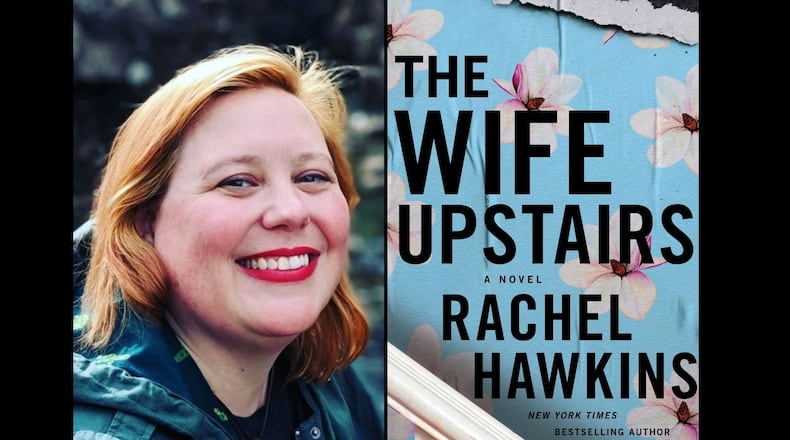Three-fourths thriller and one part reimagined classic, “The Wife Upstairs” is a feisty Southern charmer that’s twisty enough to make dinners late in kitchens everywhere.
Taking plot and character inspiration from Charlotte Bronte’s “Jane Eyre,” author Alabama author Rachel Hawkins cleverly reimagines the gothic classic by placing it in the leafy community of Mountain Brook, a suburb of Birmingham, Alabama. This time Jane is unknowingly embroiled in a love triangle, but she’s also looking out for herself ― carving out a new identity and life in the high-end village, where status and appearances seem to count more than character.
There has been a trend of late in women’s fiction to rework literary classics. A version of “Little Women” set among military wives (“The Spring Girls” by Anna Todd) and plenty of remade “Pride and Prejudices” (Atlanta’s Soniah Kamal had success with “Unmarriageable,” her version set in Pakistan) pepper bookshelves. Numerous “Jane Eyre”-inspired works include Lyndsay Faye’s delightfully wicked “Jane Steele,” where Jane becomes a serial killer/avenging angel in Victorian England.
In Hawkins’ version, admirers of “Jane Eyre” may smile as they encounter “Eddie” Rochester, zipping his sports car through the neighborhood called Thornfield Estates, the storied English names somehow fitting in quite well in this modern-day South. Despite the playfulness of the reworked names (Jane Eyre’s charge Adèle surfaces as Eddie’s Irish setter puppy), some of the more sinister characters from the classic bring their shadows with them to “The Wife Upstairs”: cold and aloof Mrs. Reed switching from Jane’s aunt to her employer and St. John River becoming John Rivers, a church employee from her past who tries blackmailing our heroine.
Jane is a fish-out-of-water, an averagely attractive young woman from out West with a mysterious past, a beat up car and a dubious living situation in a skanky apartment near strip malls. Wanting more from life, she quickly latches onto Mountain Brook’s affluent lifestyle, where Old Money meets new. Starting with a barista job, she soon finds herself walking the dogs of the wealthy, gaining enough of their trust to be able to pilfer small, valuable trinkets. Diamond earrings and gold bracelets have a way of ending up in her pockets.
As much as the reader would like to sympathize with Jane, Hawkins makes sure there are a few things about her that we should know: She’s hiding something from her past and “Jane” isn’t her real name. (It might be Helen Burns, another nod to the Bronte classic.) As these unsettling facts come to light, the reader becomes more guarded about Jane’s version of things. Tensions mount and mistrust grows as other characters weigh-in through Hawkins’ use of the multi-narrator technique.
The setting of Mountain Brook is a lush one, and Hawkins’ descriptions of rolling green lawns, well-dressed couples at backyard barbecues and chic French bistros and precious coffeeshops work well. It’s a little “too good to be true” (Jane’s reference to “Stepford Wives” is a clue), and we know there must be something lurking underneath all the sunshine and beauty. Just as in “Jane Eyre,” large, empty houses, family secrets and gossiping women wreak the same havoc regardless of the century. Trading corsets for yoga pants, the ladies of the neighborhood see (and comment on) everything, from landscaping to widowers and young, single dog-walkers.
Eddie’s wife Bea has disappeared after a boating incident that claimed the life of her best friend, Blanche (another “Eyre” name). Through memories and recollections, Bea’s story becomes a parallel of sorts to Jane’s. A successful entrepreneur who created a lifestyle “brand” based on Southern icons and imagery (think lots of gingham, beachy shell graphics and oversized crystal peaches), Bea is by all outward appearances hard for Jane to measure up to.
Gleefully skewering Bea’s company Southern Manors, Hawkins has fun with the descriptions, keeping tongue firmly in her cheek as Jane peruses the company website: “Clicking from page to page, I take in expensive Mason jars, five-hundred-dollar sweaters with HEY, Y’ALL! stitched discreetly in the left corner, silver salad tongs whose handles are shaped like bees ... It’s all expensive but useless crap, the kind of stuff lining the gift tables at every high-society wedding in Birmingham…”
Bea’s brand inspiration, it turns out, was not based on her own lifestyle but that of her bestie Blanche, a debutante raised in true white-columned elegance. Ambitious and smart, Bea (born Bertha ― a big “Jane Eyre” wink) wriggles her way into private school and college by sheer determination, co-opting Blanche’s style and monetizing it for her own benefit. Resentments and jealousy ensue, only intensifying after both women become wives and Bea’s company becomes an empire.
Fast forward to Jane and the upwardly mobile life she’s scored. It really may be too good to be true: Even as she’s donning a Southern Manor frock and sipping wine at the country club, she’s still a girl wearing dress-up clothes. And when Blanche’s body is found in the lake showing evidence of murder, both Blanche’s husband Tripp and Eddie are suspects.
Hawkins has more than 10 young adult novels under her belt, and her ability to tie up loose ends to a satisfying conclusion speak to her gift for storytelling. This is not Bronte’s tale, but a modern, rip-roaring thriller best enjoyed on a sandy beach with a tall, salty-rimmed beverage nearby.
FICTION
by Rachel Hawkins
St. Martin’s Press
304 pages, $27.99
About the Author
The Latest
Featured

